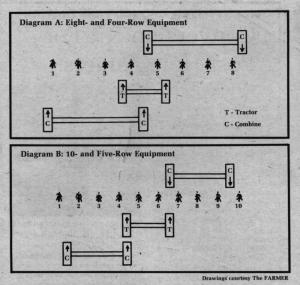1986 - Volume #10, Issue #1, Page #22
[ Sample Stories From This Issue | List of All Stories In This Issue | Print this story
| Read this issue]
Odd Row Equipment Cuts Wheel Traffic
 |
Alverson, Chester, S. Dak., switched from an even-row setup to solve two common ridge-till puzzles: How to get combine tires off ridges and how to reduce wheel traffic.
One of the first to use such a setup, Alverson modified a four-row combine and eight-row planter ù plus his cultivator ù for $3,500.
He wanted to reduce wheel traffic ù and the problems it causes when harvesting in four-row swaths and planting, cultivating and spraying eight rows at a time. Tractors and combines, often equipped with narrow duals that fit between ridges, ran on different tracks. Nearly every row was compacted ù some on both sides.
The biggest problem was running on ridges. Tires on his four-row combine lined up almost on top of the outside ridges.
Alverson, who grows 750 acres of irrigated and dryland corn, checked compacted and uncompacted yields last year to find out for himself.
Uncompacted rows yielded 180 bu. per acre; compacted rows, 160.
"More than 40% of the field had less yield," he says.
The results aren't scientific, and may not apply to all situations, but they convinced Alverson to switch.
Alverson had an added incentive. He had been planting in 38-in. rows, but 30-in. rows yield 5-10% more in his area.
"I killed two birds with one stone by switching from an eight-row to a 10-row narrow-planting system ù extra yield potential and less loss due to compaction and field traffic. And the modification held down my equipment costs," Alverson says.
Converting the combine, planter and cultivator took about 40 hrs. No cutting or welding was needed.
Tool-bar bolts were loosened and snouts, cultivator shanks and planter units were added and repositioned.
With eight - and four-row equipment, five of every eight rows were getting compacted; two on both sides (diagram A).
The tractor, pulling the planter, cultivator or sprayer, ran between rows three and four and five and six. The combine tires fit on the outside of row one and between rows four and five on one swath. On the next swath, the tires again hit rows four and five and the outside of row eight.
Since the modification (diagram B), tractor tires roll between rows four and five and six and seven. Combine tires fall between rows one and two and four and five on one swath; six and seven and nine and 10 on the next.
That reduces wheel traffic to four of the 10 rows and, more important to Alverson, no row has wheel traffic on both sides.
The ultimate in wheel traffic management would be a seven- or nine-row planting and harvesting system, says Dwayne Beck, South Dakota University research agronomist.
Beck directs the James Valley Research Center, Redfield, and is switching to a five-row harvesting and planting system next year.
In nine narrow rows, the tractor and combine, both set on 90-in. wheel tracks would run between rows three and four and six and seven.
In a seven-row setup, the combine and tractor would run between rows two and three and five and six.
To achieve the same result in an eight-row system, the combine, planter and cultivator would have to be offset.
Story and photos reprinted with permission from THE FARMER, 1999 Shepard Rd., St. Paul, MN 55116.

Click here to download page story appeared in.

Click here to read entire issue
To read the rest of this story, download this issue below or click here to register with your account number.




